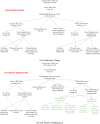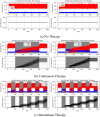Stochastic models of Mendelian and reverse transcriptional inheritance in state-structured cancer populations
- PMID: 35906318
- PMCID: PMC9338039
- DOI: 10.1038/s41598-022-17456-w
Stochastic models of Mendelian and reverse transcriptional inheritance in state-structured cancer populations
Abstract
Recent evidence suggests that a polyaneuploid cancer cell (PACC) state may play a key role in the adaptation of cancer cells to stressful environments and in promoting therapeutic resistance. The PACC state allows cancer cells to pause cell division and to avoid DNA damage and programmed cell death. Transition to the PACC state may also lead to an increase in the cancer cell's ability to generate heritable variation (evolvability). One way this can occur is through evolutionary triage. Under this framework, cells gradually gain resistance by scaling hills on a fitness landscape through a process of mutation and selection. Another way this can happen is through self-genetic modification whereby cells in the PACC state find a viable solution to the stressor and then undergo depolyploidization, passing it on to their heritably resistant progeny. Here, we develop a stochastic model to simulate both of these evolutionary frameworks. We examine the impact of treatment dosage and extent of self-genetic modification on eco-evolutionary dynamics of cancer cells with aneuploid and PACC states. We find that under low doses of therapy, evolutionary triage performs better whereas under high doses of therapy, self-genetic modification is favored. This study generates predictions for teasing apart these biological hypotheses, examines the implications of each in the context of cancer, and provides a modeling framework to compare Mendelian and non-traditional forms of inheritance.
© 2022. The Author(s).
Conflict of interest statement
KJP is a consultant for CUE Biopharma, Inc., and holds equity interest in CUE Biopharma, Inc., Keystone Biopharma, Inc. and PEEL Therapeutics, Inc. SRA holds equity interest in Keystone Biopharma, Inc. AB, RHA, EUH, and JSB declare no potential conflict of interest.
Figures







Similar articles
-
A life history model of the ecological and evolutionary dynamics of polyaneuploid cancer cells.Sci Rep. 2022 Aug 12;12(1):13713. doi: 10.1038/s41598-022-18137-4. Sci Rep. 2022. PMID: 35962062 Free PMC article.
-
A mathematical investigation of polyaneuploid cancer cell memory and cross-resistance in state-structured cancer populations.Sci Rep. 2023 Sep 12;13(1):15027. doi: 10.1038/s41598-023-42368-8. Sci Rep. 2023. PMID: 37700000 Free PMC article.
-
Empirical evidence for epigenetic inheritance driving evolutionary adaptation.Philos Trans R Soc Lond B Biol Sci. 2021 Jun 7;376(1826):20200121. doi: 10.1098/rstb.2020.0121. Epub 2021 Apr 19. Philos Trans R Soc Lond B Biol Sci. 2021. PMID: 33866813 Free PMC article. Review.
-
Mutations, evolution and the central role of a self-defined fitness function in the initiation and progression of cancer.Biochim Biophys Acta Rev Cancer. 2017 Apr;1867(2):162-166. doi: 10.1016/j.bbcan.2017.03.005. Epub 2017 Mar 21. Biochim Biophys Acta Rev Cancer. 2017. PMID: 28341421 Free PMC article. Review.
-
Cancer recurrence and lethality are enabled by enhanced survival and reversible cell cycle arrest of polyaneuploid cells.Proc Natl Acad Sci U S A. 2021 Feb 16;118(7):e2020838118. doi: 10.1073/pnas.2020838118. Proc Natl Acad Sci U S A. 2021. PMID: 33504594 Free PMC article.
Cited by
-
Modeling stress-induced responses: plasticity in continuous state space and gradual clonal evolution.Theory Biosci. 2024 Feb;143(1):63-77. doi: 10.1007/s12064-023-00410-3. Epub 2024 Jan 30. Theory Biosci. 2024. PMID: 38289469
-
Biomarkers or biotargets? Using competition to lure cancer cells into evolutionary traps.Evol Med Public Health. 2023 May 26;11(1):264-276. doi: 10.1093/emph/eoad017. eCollection 2023. Evol Med Public Health. 2023. PMID: 37599857 Free PMC article.
-
Modeling cancer's ecological and evolutionary dynamics.Med Oncol. 2023 Feb 28;40(4):109. doi: 10.1007/s12032-023-01968-0. Med Oncol. 2023. PMID: 36853375 Free PMC article.
-
Single-Cell Proteomic Characterization of Drug-Resistant Prostate Cancer Cells Reveals Molecular Signatures Associated with Morphological Changes.Mol Cell Proteomics. 2025 Apr;24(4):100949. doi: 10.1016/j.mcpro.2025.100949. Epub 2025 Mar 14. Mol Cell Proteomics. 2025. PMID: 40090465 Free PMC article.
-
The contribution of evolvability to the eco-evolutionary dynamics of competing species.Ecol Evol. 2023 Oct 11;13(10):e10591. doi: 10.1002/ece3.10591. eCollection 2023 Oct. Ecol Evol. 2023. PMID: 37829179 Free PMC article.
References
-
- Pienta, K. J., Hammarlund, E. U., Austin, R. H., Axelrod, R., Brown, J. S. & Amend, S. R. Cancer cells employ an evolutionarily conserved polyploidization program to resist therapy. In Seminars in Cancer Biology, 1–15 (2020). - PubMed
Publication types
MeSH terms
Grants and funding
LinkOut - more resources
Full Text Sources
Medical

